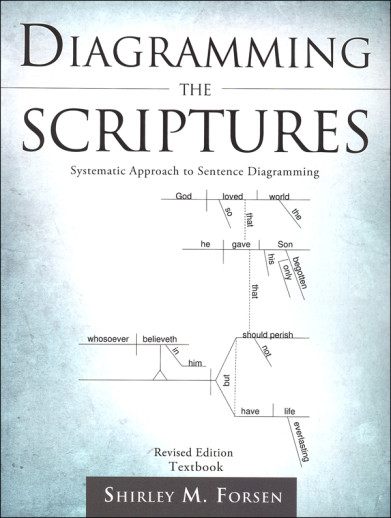We use cookies to make your experience better. To comply with the new e-Privacy directive, we need to ask for your consent to set the cookies. Learn more.
Diagramming the Scriptures
There's a certain amount of controversy over the necessity or even wisdom of diagramming sentences. Many insist it just isn't necessary for developing a good working use of grammar. I look at it a little differently. Diagramming is a graphic organizer; a tool to help us understand the relationship of words in a sentence, and thus, to help us understand our language and improve our communication skills. That being the case, what better way to "kill two birds with one stone" than to use sentences from Scripture as diagramming practice and models? In the step-by-step analysis that diagramming requires, we can come to a much richer understanding of the meaning of Scripture. The language of the KJV (the version of the Bible used in this study) can be a bit daunting, which is why the author starts at the very beginning. She reviews each part of speech (i.e. nouns, verbs, adjectives, adverbs, etc.) as well as the various parts of a sentence (subject, verbs, direct objects, etc.), teaching sentence patterns. She then builds precept upon precept, giving the student diagrammed examples, practice sentences, and ultimately tests. (Correct diagrams for all practice and test sentences are in the back of the book.) When the going gets tough and complicated (i.e. noun or adjective clauses), the author provides in-depth instruction as well as "helps" such as the "signal words" that introduce noun clauses. By the way, this is the point at which the impact of the Bible content is most realized. Sorting through a sentence in order to diagram it becomes a function of pondering God's Word. The book is a worktext with plenty of space and diagram frameworks provided. 329 pgs. pb ~ Janice
Learning how to diagram sentences can really help students visualize how the different parts of speech work together to form sentences. However, this skill isn't always included in English books. This workbook provides a wonderful supplement to any curriculum. It covers sentence diagramming from easy to challenging, one step at a time. After reading simple explanations and seeing examples, students practice with similar sentences. The worksheets start with just subjects and predicates and then progress to adjectives, adverbs, direct and indirect objects, appositives, interjections, prepositional phrases, participles, and gerunds. Reviews are scattered throughout, which can be used as quizzes or test if desired. The worksheets are perforated and reproducible. Answers included, 46 pages. - Melissa
| Product Format: | Softcover Book |
|---|---|
| Brand: | Xulon Press |
| Grades: | 9-12 |
| ISBN: | 9781609572655 |
| Length in Inches: | 11 |
| Width in Inches: | 8.25 |
| Height in Inches: | 0.75 |
| Weight in Pounds: | 1.8 |

